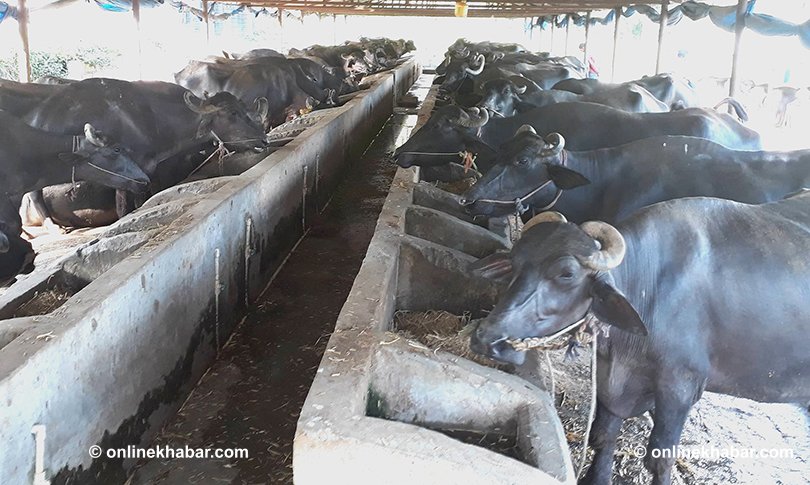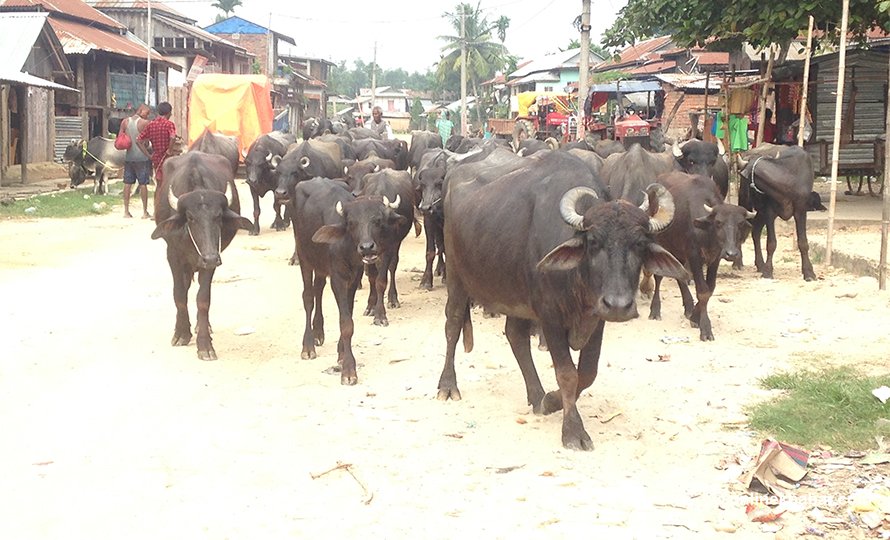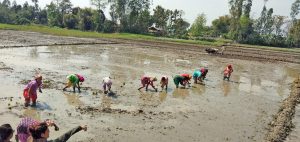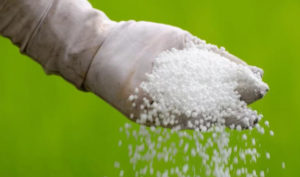
Nepali zoologists have reported the first case of the malaria parasite in water buffalos in Nepal. The alarming discovery places thousands of farmers who rear buffalos and their cattle across the country at risk.
Scientists, who uncovered the presence of the hitherto unnoticed parasites, say besides farmers, the non-farming urban group is also at risk, almost equally. Department of National Parks and Wildlife Conservation’s Deputy Director-General Ram Chandra Kandel, who led the research in 2017, informs that buffalo meat-eaters in the urban areas constitute the most vulnerable group in Nepal. “Multiple studies have found out that eating meat from diseased animals can cause various ailments.”
The finding
Interestingly, the study was not carried out as an independent research project. It was a by-product of Kandel’s PhD research. “My primary concern, for the PhD, was threats to wild water buffalos in Koshi Tappu Wildlife Reserve caused by the assimilation of domestic buffalos with the wild buffalos,” he says, “In the process; I wanted to see major diseases troubling them.”
To find out the presence of diseases in the animal, Kandel mobilised a team of other scientists to conduct the study, who hinted that the animals could be suffering from malaria.
The team collected blood samples from 56 water buffalos including 16 wild, 23 feral and 17 domestic. Of 16 wild buffalos, 13 were from the wildlife reserve whereas three were captives of the central zoo of Nepal. The domestic and feral buffalos were taken from human settlements outside the wildlife reserve. In total, three were 32 female and 24 male buffalos. Whereas the team could not identify the age of 18 buffalos, the other 38 were 15-day to 15-year-old.
During the study, one feral and one domestic buffalo were found to be contaminated with malaria parasites. “This is just four percent of our sample size, but given the implications and the lack of measures to control further expansion, it is a serious threat,” claims Kandel.
The risk
Citing similar studies for other diseases in other countries, he further added that the impacts of such meat on human health can pass onto the next generations also. “It seems one mouthful of a ‘buff’ momo that you eat can hit many generations.” He says many people cannot properly identify the causes of their diseases these days, but they fail to notice such petty issues such as where the momo meat comes from.”

Though Kandel says he does not have any specific examples about a malaria-infected buffalo meat causing health risks to humans, he seems convinced given the level of ‘carelessness’ of Nepali people about such issues.
“There are reports of bird flu almost every year in Nepal, but many people do not seem to be bothered about it anyway. The price pf chicken drops as household consumers choose not to eat chicken after such reports,” he says, “But you go to the restaurants in your neighbourhood and you find that chicken momos are equally popular notwithstanding the infection.”
Farmers’ fears
Malaria is apparently a non-communicable disease; there is no way that the cattle can spread it to farmers directly. However, the discovery of malaria in buffalos is a hint that the atmosphere that farmers are living in is prone to the infection and it affects the humans equally, according to the researcher.
Most farmers of Nepal keep their cattle close-by. In many cases, the cowsheds are within the same house that the farmers live in, which is not a problem. “But, you know how the farmers rear the animals?” Kandel explains, “The cowsheds are dirty. The manure is not removed on time. Ultimately, the places of cattle turn out to be hubs for the mosquitoes, the vectors of malaria.”
“The farmers do not care about their own health. How can we expect them to care about the animals and keep the place clean?” he questions before saying, “But, we need to realise that the risks for the animals are also the risks for people.”
On the other hand, malaria kills the cattle untimely or weakens them physically. It causes a huge economic loss to the farmers.

Remedies
The researcher suggests that different measures can be adopted at different levels to address the problems likely to be caused by the malaria parasites in buffalos. “At the domestic level, farmers should pay proper attention to cleanliness and hygiene of the animals. The cattle should be given a regular bath in clean water whereas they also need to stay covered from mosquito bites.”
As no malaria case was found in the wild buffalos during the study, Kandel claims domestic animals are at greater risk, hence improving the way farmers rear the cattle can be a great help.
At the next level, the country needs to improve animal quarantine because the risk of malaria is higher in India than in Nepal. The world’s first case of malaria in a water buffalo was reported in India whereas different recent studies covering Nagpur, Bareilly/Muktesar and Maharashtra have also indicated higher risks. Likewise, other Asian countries such as Vietnam and Thailand also have higher rates of infection, according to Kandel’s report. It is hence significant to tighten the quarantine checking, according to him.
Moreover, other animals might also be suffering from the disease but sufficient research has not been done. Kandel is aware that the sample size of his research was relatively small and should not be generalised to cause terror among farmers and stakeholders. Rather, additional studies should be carried out to determine the severity of malaria in animals of Nepal and plan a coping strategy accordingly, he recommends.

























